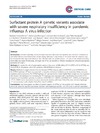Identificador persistente para citar o vincular este elemento:
https://accedacris.ulpgc.es/jspui/handle/10553/46576
| Título: | Surfactant protein A genetic variants associate with severe respiratory insufficiency in pandemic influenza A virus infection | Autores/as: | Herrera-Ramos, Estefanía López-Rodríguez, Marta Ruiz Hernández, José J. Horcajada, Juan P. Borderías, Luis Lerma, Elisabeth Blanquer, José Pérez-González, María C. García-Laorden, María I. Florido, Yanira Mas-Bosch, Virginia Montero, Milagro Ferrer, José M. Sorlí, Luisa Vilaplana, Carlos Rajas, Olga Briones, Marisa Aspa, Javier López-Granados, Eduardo Solé-Violán, Jordi de Castro, Felipe R. Rodríguez-Gallego, Carlos |
Clasificación UNESCO: | 32 Ciencias médicas 2409 Genética |
Palabras clave: | H1N1 Influenza Ozone Exposure Collectins Polymorphisms Definitions, et al. |
Fecha de publicación: | 2014 | Publicación seriada: | Critical Care | Resumen: | Introduction: Inherited variability in host immune responses influences susceptibility and outcome of Influenza A virus (IAV) infection, but these factors remain largely unknown. Components of the innate immune response may be crucial in the first days of the infection. The collectins surfactant protein (SP)-A1, -A2, and -D and mannose-binding lectin (MBL) neutralize IAV infectivity, although only SP-A2 can establish an efficient neutralization of poorly glycosylated pandemic IAV strains.Methods: We studied the role of polymorphic variants at the genes of MBL (MBL2), SP-A1 (SFTPA1), SP-A2 (SFTPA2), and SP-D (SFTPD) in 93 patients with H1N1 pandemic 2009 (H1N1pdm) infection.Results: Multivariate analysis showed that two frequent SFTPA2 missense alleles (rs1965708-C and rs1059046-A) and the SFTPA2 haplotype 1A(0) were associated with a need for mechanical ventilation, acute respiratory failure, and acute respiratory distress syndrome. The SFTPA2 haplotype 1A(1) was a protective variant. Kaplan-Meier analysis and Cox regression also showed that diplotypes not containing the 1A(1) haplotype were associated with a significantly shorter time to ICU admission in hospitalized patients. In addition, rs1965708-C (P = 0.0007), rs1059046-A (P = 0.0007), and haplotype 1A(0) (P = 0.0004) were associated, in a dose-dependent fashion, with lower PaO2/FiO(2) ratio, whereas haplotype 1A(1) was associated with a higher PaO2/FiO(2) ratio (P = 0.001).Conclusions: Our data suggest an effect of genetic variants of SFTPA2 on the severity of H1N1pdm infection and could pave the way for a potential treatment with haplotype-specific (1A(1)) SP-A2 for future IAV pandemics. | URI: | https://accedacris.ulpgc.es/handle/10553/46576 | ISSN: | 1364-8535 | DOI: | 10.1186/cc13934 | Fuente: | Critical Care [ISSN 1364-8535],v. 18, R127, (Junio 2014) |
| Colección: | Artículos |
Citas SCOPUSTM
50
actualizado el 08-jun-2025
Citas de WEB OF SCIENCETM
Citations
50
actualizado el 08-jun-2025
Visitas
121
actualizado el 13-jul-2024
Descargas
133
actualizado el 13-jul-2024
Google ScholarTM
Verifica
Altmetric
Comparte
Exporta metadatos
Los elementos en ULPGC accedaCRIS están protegidos por derechos de autor con todos los derechos reservados, a menos que se indique lo contrario.
